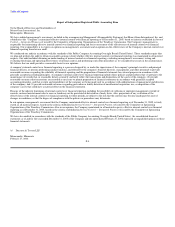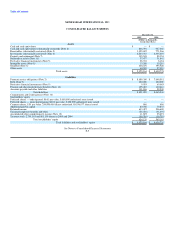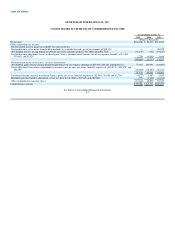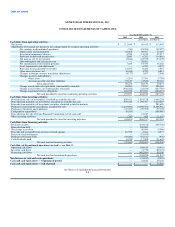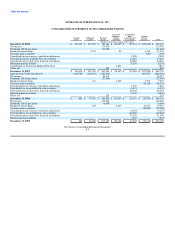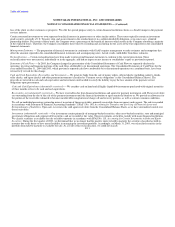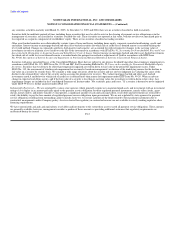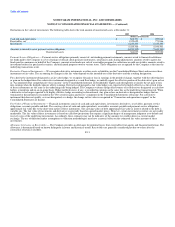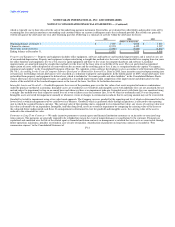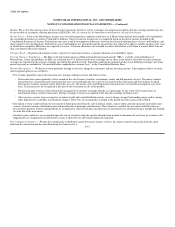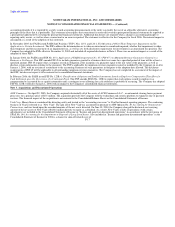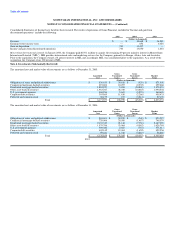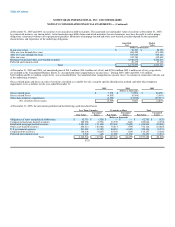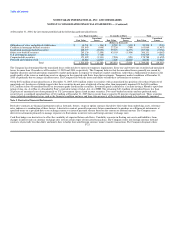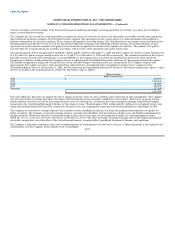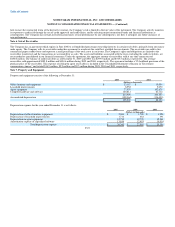MoneyGram 2005 Annual Report Download - page 68
Download and view the complete annual report
Please find page 68 of the 2005 MoneyGram annual report below. You can navigate through the pages in the report by either clicking on the pages listed below, or by using the keyword search tool below to find specific information within the annual report.
Table of Contents
MONEYGRAM INTERNATIONAL, INC. AND SUBSIDIARIES
NOTES TO CONSOLIDATED FINANCIAL STATEMENTS — (Continued)
which is typically one to three days after the sale of the underlying payment instrument. Receivables are evaluated for collectibility and possible write-off by
examining the facts and circumstances surrounding each customer where an account is delinquent and a loss is deemed possible. Receivables are generally
written off against the allowance one year after becoming past due. Following is a summary of activity within the allowance for losses:
2005 2004 2003
(Dollars in thousands)
Beginning balance at January 1, $ 7,930 $ 6,968 $ 7,863
Charged to expense 12,935 6,422 3,987
Write-offs, net of recoveries (7,046) (5,460) (4,882)
Ending balance at December 31, $ 13,819 $ 7,930 $ 6,968
Property and Equipment — Property and equipment includes office equipment, software and hardware and leasehold improvements and is stated at cost, net
of accumulated depreciation. Property and equipment is depreciated using a straight-line method over the assets' estimated useful lives ranging from ten years
for office furniture and equipment, five to seven years for agent equipment and three to five years for computer hardware and software. Leasehold
improvements are amortized using the straight-line method over the lesser of the lease term or useful life of the asset. The cost and related accumulated
depreciation of assets sold or disposed of are removed from the accounts and the resulting gain or loss, if any, is recognized under the caption "Occupancy,
equipment and supplies" in the Consolidated Statement of Income. We capitalize certain software development costs in accordance with Statement of Position
No. 98-1, Accounting for the Costs of Computer Software Developed or Obtained for Internal Use. Prior to 2005, lease incentives received upon entering into
certain leases for buildings (tenant allowances) were classified as a reduction to property and equipment. In the fourth quarter of 2005, tenant allowances were
reclassified from property and equipment to deferred rent, which is included in "Accounts payable and other liabilities" in the Consolidated Balance Sheets.
Tenant allowances for leasehold improvements are capitalized as leasehold improvements upon completion of the improvement and depreciated over the
shorter of the useful life of the leasehold improvement or the term of the lease. See Note 16 for further discussion.
Intangible Assets and Goodwill — Goodwill represents the excess of the purchase price over the fair value of net assets acquired in business combinations
under the purchase method of accounting. Intangible assets are recorded at cost. Goodwill and intangible assets with indefinite lives are not amortized, but are
instead subject to impairment testing on an annual basis and whenever there is an impairment indicator. Intangible assets with finite lives are amortized using
a straight- line method over their respective useful lives of seven to fifteen years for customer lists, 36 to 40 years for trademarks and 24 years for patents.
Intangible assets are tested for impairment annually or whenever events or changes in circumstances indicate that its carrying amount may not be recoverable.
Goodwill is tested for impairment using a fair-value based approach. The Company assesses goodwill at the reporting unit level, which is determined to be the
lowest level at which management reviews cash flows for a business. Goodwill, which is generated solely through acquisitions, is allocated to the reporting
unit in which the acquired business operates. The carrying value of the reporting unit is compared to its estimated fair value; any excess of carrying value over
fair value is deemed to be an impairment. Intangible, and other long-lived, assets are tested for impairment by comparing the carrying value of the assets to
the estimated future undiscounted cash flows. If an impairment is determined to exist for goodwill and intangible assets, the carrying value of the asset is
reduced to the estimated fair value.
Payments on Long-Term Contracts — We make incentive payments to certain agents and financial institution customers as an incentive to enter into long-
term contracts. The payments are generally required to be refunded pro rata in the event of nonperformance or cancellation by the customer. Payments are
capitalized and amortized over the life of the related agent or financial institution contracts as management is satisfied that such costs are recoverable through
future operations, minimums, penalties or refunds in case of early termination. Amortization of payments on long-term contracts is recorded in "Fees
commission expense" in the Consolidated Statement of F-14


